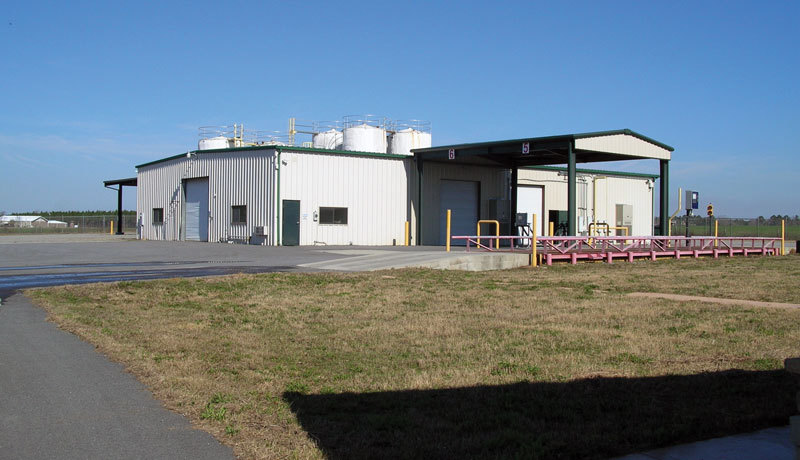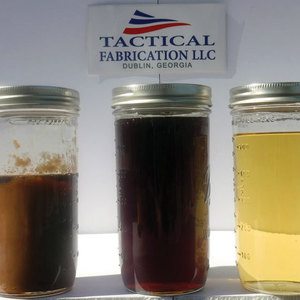Breaking New Ground



PHOTO: SMISSON-MATHIS ENERGY LLC
August 15, 2017
BY Ron Kotrba
Dublin, Georgia-based Tactical Fabrication LLC and The Smisson Group of Macon, Georgia, formed a biodiesel joint venture, Smisson-Mathis Energy LLC, to retrofit an existing, idled biodiesel production facility in Laurens County, Georgia. The process technology to be employed couples liquid enzymatic and resin technologies for conversion of brown grease to biodiesel, and advanced distillation to reduce sulfur from hundreds of parts per million (ppm) to single digits.
A pilot plant in Dublin, Georgia, scaled at 75,000 to 100,000 gallons a year, is where Franklin Mathis, CEO of Tactical Fabrication and SME, is proving out the process.
“From July 2016 to this past January, we had a small distillation unit running 100 milliliters a minute—very small—and we would perform reactions with different feedstocks and distill them in small units,” Mathis tells Biodiesel Magazine. “This January, we built the pilot unit we have running now with a 28-foot-tall column that runs 6 to 10 gallons an hour.”
The idled plant SME is purchasing to scale-up its process will initially be sized at 1 MMgy, but once running, the team will expand to 5 MMgy. Mathis originally helped build the idled plant, so he is intimately familiar with its design, which will facilitate the retrofit.
After testing trap and brown greases from all over the country, Mathis and his team quickly realized that fats, oils and greases (FOG) from wastewater treatment facilities are much cleaner feedstock than commercial brown grease. “FOG from wastewater treatment facilities has been water-washed so many times, many of the contaminants compared to brown grease have been removed,” he says. “That means once the oil has been extracted, it needs less pretreatment and there’s less crud that comes out in distillation.”
Cities all over the country pay to dispose of FOG and related wastes, but SME wants to partner with municipalities to employ its patent-pending FOG Harvester to cut the volume of waste by up to two-thirds. “Our FOG Harvester takes the waste stream and separates the water, solids and oils,” Mathis says. “Then, the water can stay at the wastewater treatment plant, the oil can be used for fuel production, and the solids can go to the landfills for digestion.”
The FOG Harvester utilizes commercially available equipment. “We’ve assembled it in a manner where we can use it in a landfill or wastewater treatment facility,” Mathis says. “The FOG Harvester pasteurizes the oil and separates the three fractions.”
Mathis says Novozymes does advertise conversion of most waste oils, but feedstocks derived from brown grease and FOG have until now been a distant dream. But, by combining Novozymes’ enzymatic process with SME’s refined advanced distillation, this dream is now becoming a reality resulting in low-sulfur biodiesel from brown grease and FOG. Mathis says the original version of the distillation process SME is using was developed and patented together with Stu Lamb of Viesel Fuel. “Stu and I own the patent, but in the past year several things have changed—we’ve encountered so many different elements in brown grease,” he says. “The learning curve has been steep and challenges have been found, but we are breaking new ground here.”
Mathis says all enzymatic processes leave a small amount of free fatty acids (FFA) unconverted. “We use Purolite resins to do the conversion on the last remaining percentage of unreacted FFA,” he says.
In early June, SME received a coveted “Green Light Letter” from USDA under the Section 9003 biorefinery assistance program to move to Phase II of a loan guarantee process, with help from Global Renewable Strategies and Consulting LLC and Sustainable Energy Strategies Inc.
Advertisement
Advertisement
Phase I involved providing USDA a rigorous external feasibility study, to indicate a solid business plan and technology selection. Phase II includes a lender’s analysis by the prospective bank and a USDA environmental assessment, says Jill Hamilton, SES founder.
“We are in the midst of completing the requirements for Phase II,” says Benjamin Smisson, SME project manager. “Part of that is a 120-day run at the pilot plant, doing data point collections, and organizing everything to USDA standards. Everything so far is looking great. We’re putting together the pieces to be ready for construction and plant modifications, and we are getting our feedstock agreements in place.”
SME’s plan is to make this a proof-of-concept plant, Smisson says. “We’d like to offer these services to a number of plants moving forward” he adds, “optimizing or designing new facilities.”
Mathis says, “Our goal is not to hide our candle under a basket. We want to make this available to every biodiesel producer.”
Author: Ron Kotrba
Editor, Biodiesel Magazine
218-745-8347
rkotrba@bbiinternational.com
Advertisement
Advertisement
Related Stories
The USDA significantly increased its estimate for 2025-’26 soybean oil use in biofuel production in its latest World Agricultural Supply and Demand Estimates report, released July 11. The outlook for soybean production was revised down.
U.S. fuel ethanol capacity fell slightly in April, while biodiesel and renewable diesel capacity held steady, according to data released by the U.S. EIA on June 30. Feedstock consumption was down when compared to the previous month.
The U.S. EPA on July 8 hosted virtual public hearing to gather input on the agency’s recently released proposed rule to set 2026 and 2027 RFS RVOs. Members of the biofuel industry were among those to offer testimony during the event.
The USDA’s Risk Management Agency is implementing multiple changes to the Camelina pilot insurance program for the 2026 and succeeding crop years. The changes will expand coverage options and provide greater flexibility for producers.
The USDA’s National Agricultural Statistics Service on June 30 released its annual Acreage report, estimating that 83.4 million acres of soybeans have been planted in the U.S. this year, down 4% when compared to 2024.
Upcoming Events










